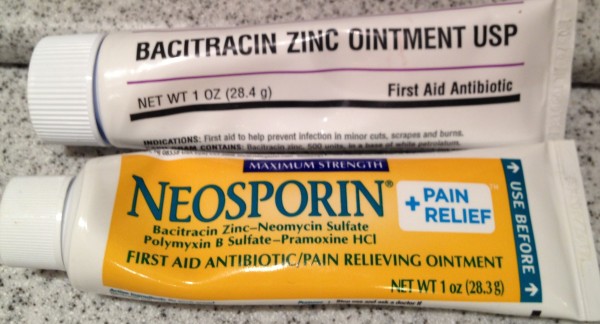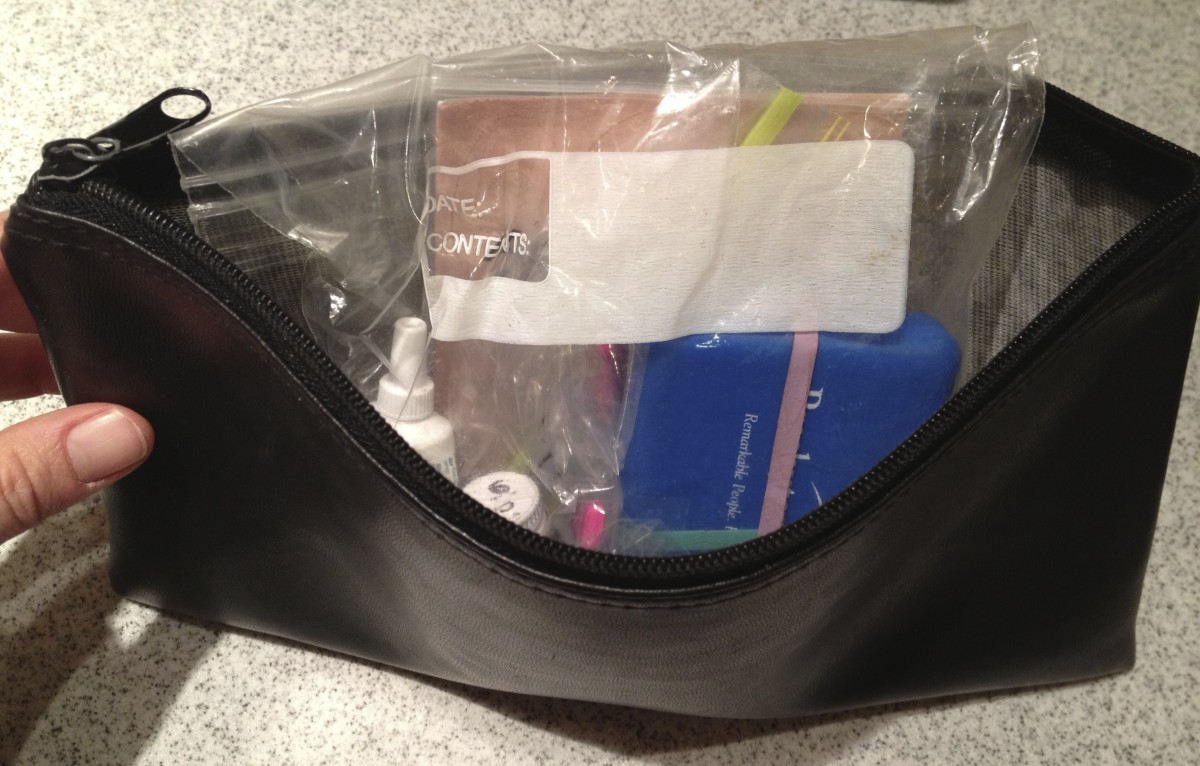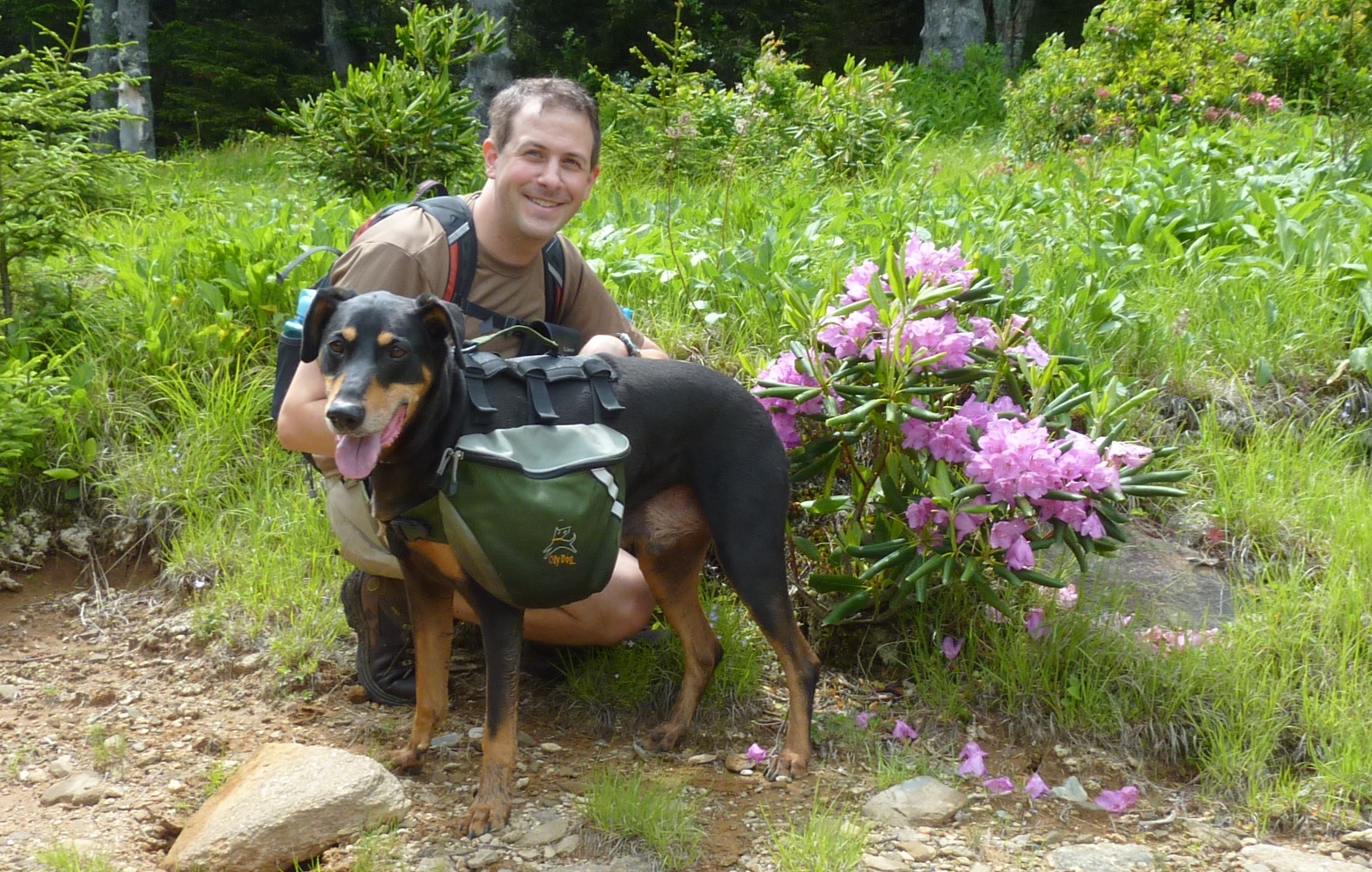What items should a backpacker carry in a first aid kit? If you hike with a dog, what extra items do you need for your furry companion?
Medical survival kits are often a boring subject, and many hikers don’t pay much attention to them. However, a survival kit is one of the most important items you carry and should not be compromised when trying to lighten pack weight. It is better to carry a few ounces more in weight than to suffer through a hike. Just imagine for a moment how you will feel when you…
- have a painful blister forming that needs moleskin
- a throbbing headache that won’t let up
- debilitating stomach cramping with spastic diarrhea
- an open laceration oozing neon goo
- find yourself caught in a cold, windy rainstorm with no way to start a fire.
Carrying a medical kit doesn’t sound so dull or fanatical now!
Here, we’ll look at the 10 essentials that will aid you (and your dog) in an emergency while keeping them simple and lightweight. This list assumes you already have the basic essential backpacking gear, such as shelter, clothing, shoes, water, food, headlight, and navigation.
DIY Backpacking First Aid Kit
10 Medical Essentials
- Moleskin (2-3 whole ‘cut-your-own’ sheets or precut templates of various sizes, depending on your preference)
- Anti-inflammatory analgesic (your preferred OTC medication of choice, such as aspirin, ibuprofen, acetaminophen, naproxen kept dry in a tiny ziplock bag with the name of the medication written on the bag; we recommend taking 2 different types: aspirin + non-aspirin; aspirin has anti-clotting properties & is not ideal for pain associated with bleeding; if you are hiking with your dog, use buffered or enteric-coated aspirin; ask your vet for the correct dose & write it down on the ziplock bag)
- Anti-diarrhea medication (depending on how bad your trail diet is, you may also require antacids, antiemetics, and laxatives kept dry in a tiny ziplock bag with the name of the medication written on the bag; Imodium (loperamide) is safe to give dogs for diarrhea, although some Collie breeds are sensitive to it; ask your vet for the dose & write it down on the ziplock bag)
- Eye drops (lubricating drops or artificial tears will help alleviate dry eyes when it is windy or dry; if a contact lens wearer, keep an extra small bottle filled with emergency saline solution, aka ‘rewetting drops’ which also acts as a general purpose eye lubricant; bring your glasses in case your eyes swell up and you cannot wear your contact lenses; see also tips on backpacking with contact lenses)
- Sterile Gauze (several 2″x 2″ sheets, suitable for lacerations that are too large for bandaids; put in a small zipper bag if not individually packaged to keep sterile)
- Adhesive waterproof tape (3-4′ long of 1″ wide tape rolled onto a popsicle stick or sewing thread bobbin)
- Bandaids, assorted sizes (3 adhesive bandages of each size from a variety pack)
- Butterfly bandages (6, used to hold together the edges of a cut to expedite healing; larger cuts may require several butterflies)
- Antiseptic wipes (4 – 6 alcohol or iodine wipes, unscented to prevent attracting wildlife; act as an antiseptic for cuts & lacerations; alcohol wipes can also be used as emergency fire starter; alcohol is painful for open wounds on dogs; use iodine wipes on dogs)
- Electrolyte tablet (1-2 tablets, such as Emergen-C, to replace lost minerals caused by excessive sweating or illness)
*  Why not a “triple antibiotic” cream? Clinical trials demonstrate that antibiotic topical ointments, such as Neosporin, are no more effective than petroleum jelly at treating wounds; instead, they are often the cause of contact dermatitis and antibiotic resistance. No topical antibiotic, including bacitracin, is as helpful as simply cleaning the wound with biodegradable soap and water (or wiping with iodine or alcohol) and keeping it clean and protected with a bandage.
Why not a “triple antibiotic” cream? Clinical trials demonstrate that antibiotic topical ointments, such as Neosporin, are no more effective than petroleum jelly at treating wounds; instead, they are often the cause of contact dermatitis and antibiotic resistance. No topical antibiotic, including bacitracin, is as helpful as simply cleaning the wound with biodegradable soap and water (or wiping with iodine or alcohol) and keeping it clean and protected with a bandage.
10 Tool Essentials
- Duct tape (roll about 3′ on the outside of your reusable water bottle or trekking poles; or wrap around popsicle stick/sewing thread bobbin and keep in kit)
- Tweezers (ones that will remove ticks & splinters from yourself or your dog; test the plastic ones beforehand; most don’t work very well)
- Safety pins (2 large pins; can be used for gear, to secure bandages, dig out a splinter, etc.)
- Needle with thread (keep in a matchbox; useful for gear repair & digging out a splinter)
- Medical gloves (1 pair of nitrile surgical or non-latex barrier gloves; the sanitary option if you need to help someone who is bleeding or want them to help you!)
- Waterproof matches & fire starter (windproof & waterproof emergency matches to start a fire in bad weather; make your own fire starter at home by collecting dryer lint, add to the inside of a paper egg carton, fill it with melted candle wax & cut away once dried)
- Emergency blanket (aluminum style reflective blanket if you are hiking in cold or wet weather when hypothermia can be a concern; these can retain up to 80% of your radiated body heat & have other uses, including an emergency signaling device if stranded, a ground cover kept under the tent, an insulator when placed under your sleeping bag and over your air mattress/pad)
- Water purification tablets (your preferred backup choice, such as iodine tablets, potable aqua, or chlorine drops; always carry alternative water purification if your pump gets clogged, your UV lamp breaks, or you run out of fuel to boil water)
- Single-edge razor blade (even if you carry a multi-purpose knife, have a back-up blade)
- Fingernail clippers (long toenails can cause many problems during long downhill treks! Be sure to trim your dog’s nails before hiking;)
Optional Additions
These additions greatly depend on your circumstances. Maybe you’d rather be “extra” prepared and don’t mind the added mass.
- Prescription medication (medication that your life depends on, e.g., insulin, heart, and blood pressure; if you are hiking in extremely secluded wilderness areas, also consider asking your doctor to prescribe a limited prescription reliever, such as Hydrocodone, to get you through any injuries, such as broken bones, until you can walk to the nearest medical facility.)
- Antihistamines (if you suffer from allergies or sleep problems, Diphenhydramine (Benadryl) is a suitable all-purpose medication that works quickly and is safe for dogs; obtain the dose from your vet)
- Epi-pen (you suffer from severe allergic reactions)
- Hydrocortisone cream (reduces swelling and itching caused by insect bites and stings; this is optional since most people experience mildly annoying reactions rather than debilitating; look for a small travel-size tube)
- Antibiotic ointment (use with discretion; soap & water or iodine/alcohol wipes are reliable for pre-treating wounds, followed by a bandage to keep it clean and protected)
- Antihemorrhagic (agent to stop bleeding quickly, such as Quikclot or cornstarch, which is helpful for dogs and humans)
- Lip Balm with sunscreen (chapped lips can become painful if infected; see our natural methods of healing chapped lips)
- Insect Repellent (if traveling in heavily infested areas)
- Multivitamins (if health conscious, have a special diet, or plan to eat poorly and are concerned by the nutritional deficit)
- Snake Bite Kit (e.g., a Sawyer extractor pump kit can be used for spider or snake bites; we highly recommend bringing this along if you are hiking in heavily secluded areas with known poisonous snakes or with a dog who likes to put his feet and nose under rocks!).
- Activated charcoal (for those hiking with dogs, can be used to absorb ingested poisons; check with poison control for proper dosage)
- Dog Boots (to protect a dog’s pads, which can get tender and sore when hiking extended miles, in rocky terrain, or on snow/ice)
- Baby Wipes (extra wipes to keep you and your dog clean when nothing else will work – i.e., your dog rolls around in something nasty)
- Anti-chafing / Anti-friction (skin protectant when you are in wet, hot and humid conditions)
- Superglue (when duct tape won’t do)
Storing the Essentials
Look around your house to find something you already have to store your first aid items in. You will want something lightweight and waterproof. Look for a hard plastic case that snaps shut. A money deposit bag works well and can be found at most office supply stores for $5 or less. A thicker ziplock freezer bag will also work as a last resort, but it is not the best choice since it can snag over time.

As you can see, there is no need to get elaborate and purchase a top-rated commercial first-aid kit with extra items you don’t need. You can easily make your own DIY backpacking first-aid kit with these essentials, and you’ll be better prepared for most emergency situations.
Consider the Conditions
In general, the location and conditions you are hiking in will dictate the essentials you will take in your medical kit and those you keep on yourself and as part of your daily gear. For example, if hiking in sunny, exposed areas, you should protect your skin and wear a wide-brim hat and sunglasses. If traveling in cold and snowy regions, have a warm hat, gloves, and extra socks, which can double as mittens if your gloves are lost. If hiking in rainy and wet regions such as the Pacific NW and the Appalachians, rain gear and a small anti-fungal ointment is a good idea. If hiking in areas with active bear populations, carry a whistle and pepper spray. If you hike with your dog, program the emergency veterinarian phone number and animal poison control into your cell phone. Regardless of the terrain or weather, always take an extra change of clothing and socks with you. Proper insulation is a critical essential to enjoying the outdoors.
Stay safe out there!


4 thoughts on “10 Essential Tools in Your Backpacking First Aid Kit”
Thank you for your list!
One thing though, no. 3 Anti-diarrhea medication. Pharmacists do not advice to take Imodium or such medication when having infection related diarrhea (food intoxication or gastroenteritis), because it keeps the contaminated stools longer in the intestins. The best approach is to let the body do what it has to do and take rehydratation solutions in small quantities every hour. These solution can be bought in single use portions and need to be precisely mixed with the amount of clean water indicated on the package. One important thing is to clean your hands really often and your material that might have been contaminated.
That’s a great list you have mentioned there, covering all the essential items which SHOULD be carried in your adventure trip without making your luggage heavy. I have a few suggestions that you can use along with the above mentioned, infact I have them in my household list as well. Some of the items are:
1. Instant Cold Compress
2. Wooden Split 1.5″ x 9.5″
For emergency fire starter, I use cotton balls instead of dryer lint. A lot of dryer lint nowadays has synthetic material that does not ignite as readily as cotton. Soak the cotton balls in petroleum jelly and dip them in melted beeswax. These burn easily and the wax keeps them burning.
Love This! Tells me good information!